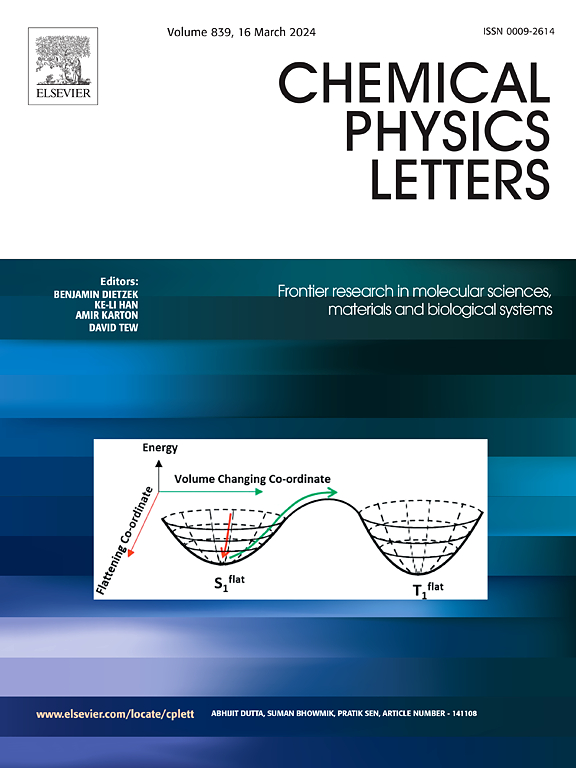改性片状微介孔TS-1沸石载钴催化剂上4-乙基甲苯绿色氧化制4-甲基苯乙酮
IF 3.1
3区 化学
Q3 CHEMISTRY, PHYSICAL
引用次数: 0
摘要
开发高效的4-乙基甲苯绿色氧化催化剂是解决4-甲基苯乙酮合成技术的关键。本文采用浸渍法将氧化钴负载在连续改性片状微介孔TS-1 (FL-TS-1)沸石上。在60℃的间歇反应器中,以30 wt%的过氧化氢(H2O2)为溶剂,乙酸为溶剂,溴化钾为添加剂,氧化4-乙基甲苯。由于催化剂的活性形态和形状选择性,4-乙基甲苯侧链上乙基的仲碳原子被选择性催化生成主产物4-甲基苯乙酮。全面考察了各参数对反应的影响。结果表明,负载5 wt%钴的FL-TS-1-TPAOH@T + S催化剂表现出最佳的反应活性。利用x射线衍射(XRD)、扫描电子显微镜(SEM)、透射电子显微镜(TEM)、傅里叶变换红外光谱(FT-IR)、紫外可见光谱(UV-Vis)、氮气吸附和x射线光电子能谱(XPS)对样品的形貌、孔隙结构和表面元素进行了表征和分析。根据反应活性数据,对反应机理和自由基过程进行了讨论。本文章由计算机程序翻译,如有差异,请以英文原文为准。

Green catalytic oxidation of 4-ethyltoluene to 4-methylacetophenone over modified flake micro-mesoporous TS-1 zeolite supported cobalt catalysts
The development of efficient catalyst for the green oxidation of 4-ethyltoluene is crucial for addressing the synthesis technology of 4-Methylacetophenone. In this paper, cobalt oxide was loaded on continuously modified flake micro-mesoporous TS-1 (FL-TS-1) zeolite by impregnation method. In a batch reactor at 60 °C, 4-ethyltoluene was oxidized using 30 wt% hydrogen peroxide (H2O2) with acetic acid as the solvent and potassium bromide as an additive. Due to the active species and shape selectivity of the catalyst, the secondary carbon atom of the ethyl group on the side chain of 4-ethyltoluene is selectively catalyzed to form the main product 4-methylacetophenone. A comprehensive investigation was conducted on the influence of various parameters on the reaction. The results showed that the FL-TS-1-TPAOH@T + S catalyst with 5 wt% cobalt loading exhibited optimal reaction activity. The morphology, pore structure and surface elements of the samples were characterized and analyzed utilizing X-ray diffraction (XRD), scanning electron microscopy (SEM), transmission electron microscopy (TEM), Fourier-transform infrared spectroscopy (FT-IR), ultraviolet-visible spectroscopy (UV–Vis), nitrogen adsorption, and X-ray photoelectron spectroscopy (XPS). The reaction mechanism and free radical processes were discussed based on the reaction activity data.
求助全文
通过发布文献求助,成功后即可免费获取论文全文。
去求助
来源期刊

Chemical Physics Letters
化学-物理:原子、分子和化学物理
CiteScore
5.70
自引率
3.60%
发文量
798
审稿时长
33 days
期刊介绍:
Chemical Physics Letters has an open access mirror journal, Chemical Physics Letters: X, sharing the same aims and scope, editorial team, submission system and rigorous peer review.
Chemical Physics Letters publishes brief reports on molecules, interfaces, condensed phases, nanomaterials and nanostructures, polymers, biomolecular systems, and energy conversion and storage.
Criteria for publication are quality, urgency and impact. Further, experimental results reported in the journal have direct relevance for theory, and theoretical developments or non-routine computations relate directly to experiment. Manuscripts must satisfy these criteria and should not be minor extensions of previous work.
 求助内容:
求助内容: 应助结果提醒方式:
应助结果提醒方式:


